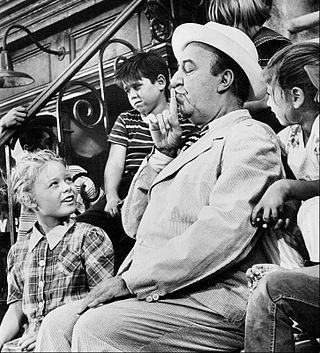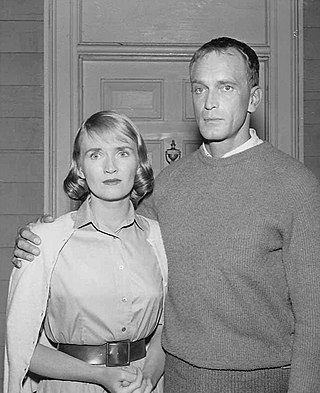
"Where Is Everybody?" is the first episode of the American anthology television series The Twilight Zone and was originally broadcast on 2 October 1959, on CBS. It is one of the most realistic Twilight Zone episodes, as it features no supernatural elements and is based on fairly straightforward extrapolation of science.

"One for the Angels" is the second episode of the American anthology television series The Twilight Zone. It originally aired on October 9, 1959, on CBS television.
"What You Need" is the twelfth episode of the American television anthology series The Twilight Zone, airing on Christmas Day, 1959. It is based on the short story of the same name by Lewis Padgett, which was published in the October 1945 issue of Astounding Science Fiction magazine.
"I Shot an Arrow into the Air" is the fifteenth episode of the American television anthology series The Twilight Zone.

"The Monsters Are Due on Maple Street" is the 22nd episode in the first season of the American television anthology series The Twilight Zone. The episode was written by Rod Serling, the creator-narrator of the series. It originally aired on March 4, 1960, on CBS. In 2009, TIME named it one of the ten best Twilight Zone episodes.

"The Big Tall Wish" is episode twenty-seven of the American television anthology series The Twilight Zone, with an original score by Jerry Goldsmith. It originally aired on April 8, 1960, on CBS. This was one of a few Twilight Zone episodes to feature black actors in lead roles, a rarity for American television of the era.
"Nick of Time" is episode 43 of the American television anthology series The Twilight Zone. It originally aired on November 18, 1960 on CBS.
"The Whole Truth" is episode 50 of the American television anthology series The Twilight Zone. It originally aired on January 20, 1961 on CBS. It was one of the six episodes of the second season which was shot on videotape in a short-lived experiment aimed to cut costs.
"The Night of the Meek" is episode 47 of the American television anthology series The Twilight Zone. It originally aired on December 23, 1960, on CBS. It was one of the six episodes of the second season which were shot on videotape in a short-lived experiment aimed to cut costs.

"Long Distance Call" is episode 58 of the American television anthology series The Twilight Zone. It originally aired on March 31, 1961, on CBS. In the episode, a 5-year-old boy named Billy communicates with his dead grandmother using a toy telephone that she gave him on his birthday. It was one of the six episodes of the second season which was shot on videotape in a short-lived experiment aimed to cut costs.
"It's a Good Life" is the eighth episode of the third season of the American television series The Twilight Zone, and the 73rd overall. It was written by series creator/showrunner Rod Serling, based on the 1953 short story "It's a Good Life" by Jerome Bixby. The episode was directed by James Sheldon, and is considered by some, such as Time and TV Guide, to be one of the best episodes of the series. It originally aired on November 3, 1961. The episode was one of four from the original 1959 series which formed the basis of the 1983 film Twilight Zone: The Movie.
"Still Valley" is episode 76 of the American television anthology series The Twilight Zone.

Rickenbacker was a Vintage Era automobile manufactured in Detroit, Michigan, from 1922 until 1927. The car is best known for pioneering production of four-wheel brakes.

"The Bard" is an episode of the American television anthology series The Twilight Zone. It was the final episode of The Twilight Zone to be one hour long. A direct satire of the American television industry, the episode features a parody of Marlon Brando by Burt Reynolds, and concerns an inept screenwriter, who through the use of black magic, employs William Shakespeare as his ghostwriter.
"A Short Drink from a Certain Fountain" is an episode of the American television anthology series The Twilight Zone. In this episode, a scientist gives his brother an experimental youth serum in order to save his marriage to a much younger woman. The episode's title refers to the mythical Fountain of Youth.
"Caesar and Me" is episode 148 of the American television anthology series The Twilight Zone starring Jackie Cooper as a ventriloquist. It is not to be confused with a similar episode "The Dummy", starring Cliff Robertson as a ventriloquist.

"Once Upon a Time" is episode 78 of the American television anthology series The Twilight Zone. It originally aired on December 15, 1961. It features early film star Buster Keaton in one of his later roles, as an unlikely time traveler, and the opening and closing scenes pay tribute to the silent films for which he was famous.
"The Jungle" is episode 77 of the American television anthology series The Twilight Zone, and is the twelfth episode of the third season. It first aired on December 1, 1961. This teleplay was written by Charles Beaumont, based on his short story of the same name, and was directed by recurring director William F. Claxton.
"Cavender Is Coming" is episode 101 of the American television anthology series The Twilight Zone. It originally aired on May 25, 1962 on CBS.
"You Drive" is episode 134 of the American television anthology series The Twilight Zone. It originally aired on January 3, 1964, on CBS. In this episode, the perpetrator of a fatal hit-and-run is hounded by the car he committed the crime with. Earl Hamner Jr. reprised this story, as he had already used it in the 1954 TV series 'Justice'.








